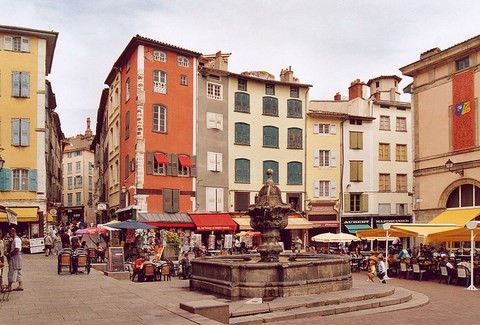Puy in velay (photo: the departure of the GR 65)

After having conquered this site inhabited by the Vellavi (Gallic tribe), the Romans settled in le Puy, then called Anicium.
It is in the 6th century that Podium Aniciense began to gain importance. At that time, and since the 3rd century, the diocese was Ruessio (paulien).
After the fall of the Roman Empire, barbarian depart, paulien was not spared. The ransacked town, its inhabitants massacred, destroyed Roman houses, the Bishop Vosy renounced rebuild. He decided to settle in le Puy, whose position was easier to defend, and the more favourable situation.
From the 10th century, the Velay becomes county diocese, in favour of the Bishop of le Puy. The city became the capital of le Velay, seat of the County and the bishopric. Thus Le Puy became the capital of the Vellavi.
Miracles occurred on Mont Anis, Bishop Vosy entrusted to Scutaire, Roman architect, the mission to erect a church.
Already famous due the healings operated by the 'stone to fevers,' which leads there even some Muslims who came from Spain, the city became more when St. Louis made him don the Black Madonna. Therefore, Le Puy enjoyed great prosperity, due to the arrival of thousands of pilgrims. This pilgrimage of le Puy remained, during the middle ages, the most famous of France, as one of the four major routes leading to Santiago de Compostela passed there. The Bishop Godescalc is cited as the first Pilgrim to Compostela in 951.
In 1095, Pope Urban II appoints Bishop of le Puy, Adhemar of Le Puy as legate for the first crusade.
Tour Pannessac
At the time of feudalism, the Velay was given as an appanage to the Duke of Guyenne, William of Auvergne. In 1162, a dispute arose between it and the Bishop of le Puy. The latter, having been molested, took the case to the King of France Louis VII the young, which gave reason to the prelate and withdrew his County to William to offer it to the Bishop. Therefore, it lifted, for the time, that of the sovereign who, in 1307, was definitely the Velay to the royal domain, Philippe le Bel now sharing his lordship with the Pontiff. This, in order to make room in the Polignac, true dynasty, the most illustrious of the region, that kidnapping rich pilgrims and many merchants attracted by the prospect of successful business.
If the King of France decided to intervene, it is that before him a poor Carpenter, Durand, had declared holy war on these «Cotereaux.» Having received mission of the Virgin to bring able-bodied men, he gave hunt to these adventurers, which he hung up to 500 at a time. The taste of blood resulted in these new Crusaders in such excess that the King had to put good order. Where the Treaty of sharing of 1307. The Bishop, who had relied on traders to withstand the Polignac, make concessions and Le Puy became a municipality electing its consuls.
Le Puy, in the middle ages, is a religious city but also a prestigious literary city. The Academy of Saint-Mayol welcomes students from any of the Occitania. The city is also renowned for its poetic course in the language of oc.
The Velay depends on after that date of the royal Government of Languedoc, an independent Seneschal remains in the Puy until 1789.
In addition to his pilgrimage, Le Puy also owes part of its prosperity to its lace, first mentioned in 1408. Unfortunately, in 1640, the Parliament of Toulouse, attacked claims by nobles and bourgeois who complained of no longer find servants (there were at this time the area 70 000 women making lace on their tile) prohibits the port on the clothes, where desolation and unemployment among the dentelieres. It was then that Saint François Régis, father Jesuit, moved to this situation, managed to set aside the decision of the Parliament.
Le Puy still victoriously resisted the attacks of the Cevennes Huguenots who did great damage to the city. The Bishop, Senectaire Mr, took the sword and attaches the breastplate to repel off the enemies of the Virgin. For several months, Le Puy refused to recognize Henry IV as King of France despite his abjuration.
The revolution, the Velay followed the fate of all the old French provinces and under the Empire, became the Department of Haute-Loire with Le Puy as capital.
At the end of World War II, the city is liberated by the 1re DB [2] late August 1944.
http://www.OT-lepuyenvelay.fr/_fichiers/file/Presse/Dossier_de_presse.PDF